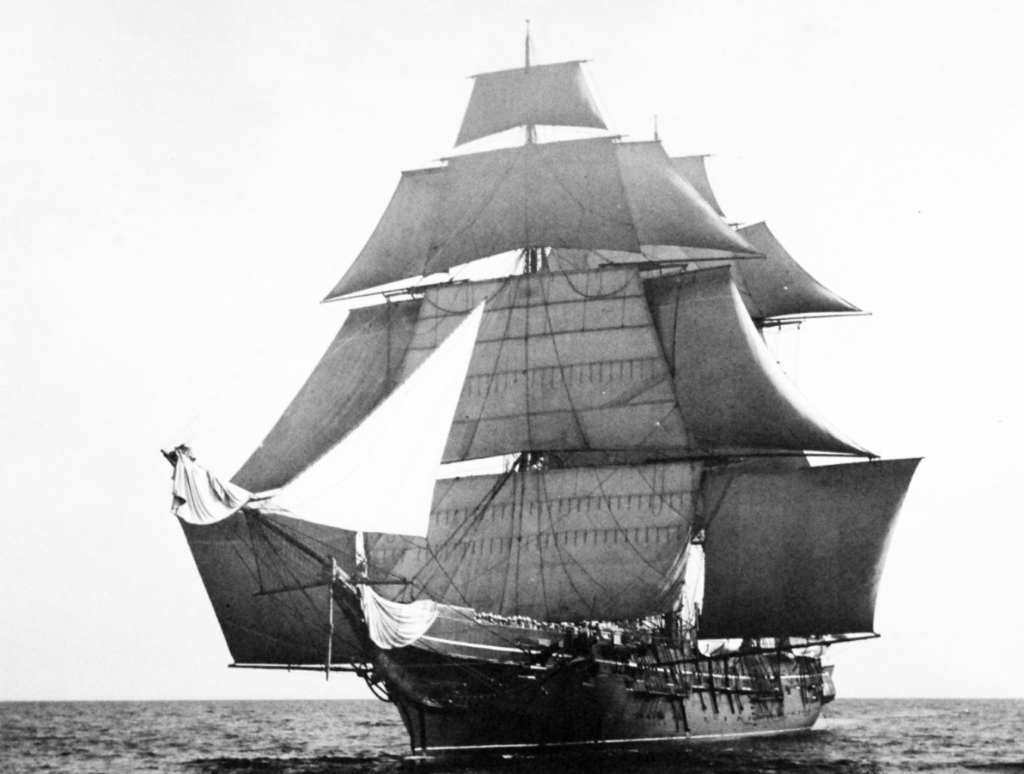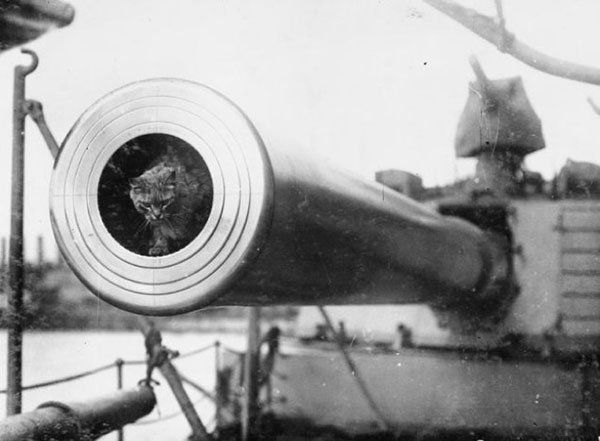
When the United States Navy gunboat Annapolis arrived in New York in September 1899, Commander Ingersol told his crew he would provide them as much shore leave as possible. One crew member, however, was not permitted to go on land. That was Tom the Terror, the official rat killer and feline mascot of the USS Annapolis.
According to the press (the story was covered nationally), Tom “had forfeited all liberty until the completion of the cruise.” Although he was not in irons for having committed the serious offense of attacking an officer, he had a history of being a deserter from the United States Navy. Commander Ingersol was not about to let his champion ratter desert his ship in New York City on his watch.
Tom the Terror was reportedly a noted figure in the United States Navy. He came from a long line of naval cats, having been born on the Cob Deck at the Brooklyn Navy Yard in 1896.* All of his siblings and cousins had also honorably served in the United States Navy as rat killers and mascots.
Tom spent the first two years of his life catching the rats and mice that had overrun the Brooklyn Navy Yard in the 1890s. He officially joined the United States Navy in 1898, when he decided to stroll on board the USS Terror while the ship was laying at the yard. After making a careful survey of the quarters and crew, Tom roamed around the quarter-deck, curled up on the rug in the captain’s cabin, and fell asleep.
By this time, Tom had already made a name for himself as the terror of the Brooklyn Navy Yard. Having fought every cat on land, Tom apparently decided to fight for his country on board the aptly named USS Terror.

Tom was immediately adopted by the crew of the Terror, and full enlistment papers were drawn up giving him the rank of rat killer and mascot. The papers were properly filed, and Tom’s life at sea as a member of the United States Navy began.
Following Tom’s service during the Spanish-American War, where he worked alongside other navy cats such as Tom of the USS Maine, the USS Terror returned to northern waters. Tom and the rest of the crew joined the receiving ship Franklin.
From the Franklin, Tom was transferred to the USS Monongahala, which at this time was a ship-rigged sail training ship for the United States Naval Academy. Life on board the ship was made as pleasant as possible for Tom, but as they say, you can take the cat out of Brooklyn, but you can’t take the Brooklyn out of the cat.
Tom was a fighter. He scratched two of the officers, bit another man, “and exhibited an appetite that bordered on gluttony–a sin not to be tolerated in the navy or in any other walk of life.” Although the men continued to love him, they were obligated to report his shortcomings in his naval papers.

On June 3, 1899, the Monongahela was docked beside the Annapolis at Norfolk, Virginia. Tom no doubt overheard discussions about the pleasure cruise the Annapolis was about to make with the naval cadets on board. The trip included stops at the Naval Station at Newport, Rhode Island, and the U.S. Military Academy at West Point. Tom deserted the Monongahela and joined the Annapolis.
Just before the Annapolis was about to weigh anchor, Commander Ingersol received a message from the Monongahela, asking if they had a tawny stowaway cat on board. The commander ordered a search, but Tom the Terror was nowhere to be found.
When the bugle call for supper was sounded later that day, Tom appeared from the depths of the forecastle. He climbed upon one of the guns, looked around to see if the Monongahela was still in sight, and, finding himself safe, he proudly marched up to the bridge. There, he gazed calmly into Commander Ingersol’s eyes and began purring.

Now, Commander Ingersol knew that this was Tom the Terror. He also knew that the cat would now be labeled as a deserter. He couldn’t take him back to land, so he did the next best thing: he adopted Tom as a member of the ship’s company.
Tom quickly made friends with the crew and the cadets. He did not respect rank, and he made his own rules, but the men adored him.
Tom loved to sit and purr for hours at Lieutenant Commander Bartlett’s side. He also enjoyed play-scratching and teasing the cadets, and stealing morsels of food from the crew. He was a great ratter, and over time, he proved himself a worthy mascot of the Annapolis.
As for the Monongahela, Tom was listed in that ship’s books as a deserter. One reporter noted that he may have to face a court martial for that crime, but for the time being, he was very content on the Annapolis.
Tom’s only complaint: the Annapolis didn’t have any other ship cats, so he couldn’t practice the cat-fight moves that made him famous in Brooklyn. That was probably a good thing.

*Tom’s place of birth was disputed in July 1899, when a man named T.S. Hamlin from Anaconda, Montana, claimed that Tom was born in Montana and taken away by a man named Hartman Matthews. A search for this man was made, but he was never found, and his name did not appear in the town’s directory.



